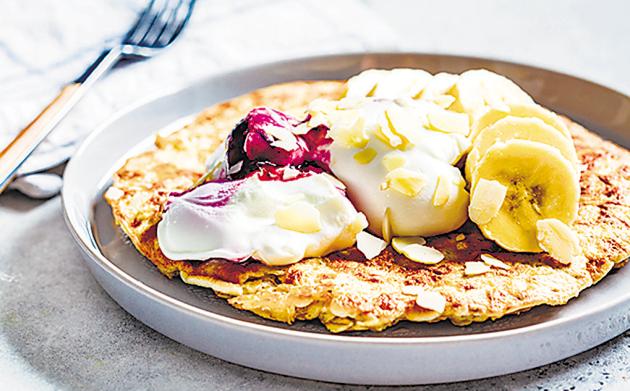How the omelette won my heart: Kunal Vijayakar on his love for the Parsi pora
The pora is an omelette so packed with ingredients that you can hardly taste the egg — much like the original omelette itself.
I was never a big fan of omelettes. It’s either something about the texture or the way egg undercooks between the folded layers, or the floppiness of an overcooked and flattened omelette that is redolent of raw onion that sort of turned me away from omelettes for most of my life.

I’d watch my grandmother painstakingly separate yolk from egg and then wrist-wrenchingly beat the white till peaky, add onions, chillies, tomato, salt, and gently fold in the yolks, ensuring the eggs were aerated enough to make rather fluffy omelettes. I’d watch, but never eat.
Even all those years at college, hanging around in a canteen where vada pav, misal pav and omelette pav were the three staples, I never succumbed. It didn’t help that a sweaty man haphazardly broke the eggs, mixed them quickly in a mug, with raw onion, green chillies and salt, then poured the mix onto an oily pan to make small pancakes, which were hurriedly taken off the fire before the eggs had gained even a blush of bronze. I never had one in all my years there.
Even at breakfasts at Trattoria (at the erstwhile Taj President hotel), I’d watch my friends demolish huge omelettes, pale yellow, pillow-like and podgy, with only gently wrinkled skin, bursting with melted cheese, ham and mushrooms, and adamantly stick to my runny sunny-side-ups. It was only when I first tasted the Parsi pora that I actually took to the omelette. For me, the egg in the Parsi pora is just the binder. This omelette is crammed with Indian flavours and masala. The best pora contains fried onion. Deep-fried. The eggs are mixed with this browned, crisped onion, a fistful of coriander, garlic, ginger, red chilli powder, haldi, jeera powder and dhansak masala, then beaten well to form a dark-brown liquid.
You pour portions of this mixture into oil to deep-fry these pancakes. The way my friend Zenobia Irani cooks them is to keep them frying till they turn crispy brown, taking them off the fire only just before they start to burn. This pora comes out crisp, frilly, dark brown and so savoury that you could actually be eating a cutlet.
If you don’t have a friend called Zenobia, you can try the omelettes they sell at outlets of the RTI or Ratan Tata Institute. They come somewhat close to the real thing, though you will need to re-heat these properly before eating (ideally with soft, fresh, Wibs sandwich bread).
The pora is an omelette so packed with ingredients that you can hardly taste the egg — much like the original omelette itself. When I looked it up, I discovered that the earliest recorded omelettes came from Persia. They were called kuku sabzi and are still hugely popular in Iran and other Middle-Eastern countries.
The kuku sabzi is a flat, green preparation, much like the Parsi pora, except that it’s stuffed with parsley, coriander, herbs, dill, spinach and scallions. In this case, the omelette is either baked or steamed over a low flame. Topped with sour Irani barberries and walnuts, it is a meal in itself.
Like most foods in life, once the French got their hands on it, the omelette began to be perfected and documented. So if you pick up a thick Larousse Gastronomique, the French almanac of cooking, you may get a perfect recipe. Eight eggs mixed with a little water and cream or milk, seasoned with salt and pepper, beaten and then poured into a pan. The eggs are then stirred and mixed with a fork till they start setting; then folded and left to form an omelette. That is the plain omelette.
I’d suggest you read the book when you have lots of time, because the Larousse has over 35 omelette recipes, including omelettes stuffed with truffles, asparagus, morel mushrooms, chicken liver, cauliflower, bacon, potatoes, horseradish, foie gras, or even fruit compote, nuts and pastry.
Be that as it may, the best omelettes I have eaten after the Parsi pora are the Asian omelettes. Any Singapore food court hawker will serve you an oyster omelette, also called orh luak, with a side of spicy chilli sauce and a wedge of lime. It is to die for. Likewise the egg foo young, which is a Cantonese dish you can find easily in Old Kolkata. It can be made with eggs and pak choy or stuffed with barbecue pork (char siu) or ham. Often, Chinese homes just use any leftover meat, chicken or shrimp to rustle up a quick omelette.
That’s not all. It seems like everyone has their own version. The Spanish omelette is celebrated. It’s baked in a pan with eggs and potatoes. The Italians make frittata — eggs, meat, cheese and vegetables. And we in India of course make the masala omelette. I think it was the masala that finally converted me from a non-omelette-eater to an omelette fiend. Go to any Irani eatery in Mumbai, and you’ll know what I mean.



